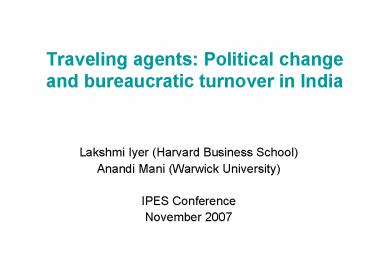Traveling agents: Political change and bureaucratic turnover in India
1 / 10
Title:
Traveling agents: Political change and bureaucratic turnover in India
Description:
Construct transfer dummy for each officer in each year; count multiple transfers ... MeanTransferkt = ak bt cPolChangekt ekt ... –
Number of Views:46
Avg rating:3.0/5.0
Title: Traveling agents: Political change and bureaucratic turnover in India
1
Traveling agents Political change and
bureaucratic turnover in India
- Lakshmi Iyer (Harvard Business School)
- Anandi Mani (Warwick University)
- IPES Conference
- November 2007
2
Motivation
- Relationship between elected politicians and
appointed bureaucrats large theoretical
literature on normative and positive aspects, but
relatively little empirical work, especially in a
developing country context. - Political interference in the bureaucracy is a
major public policy concern in India Public
Services Bill under consideration to further
insulate bureaucrats from politicians. - We use data from the Indian Administrative
Service (top level of Indian bureaucracy).
Politicians have very limited ability to hire and
fire bureaucrats, so main margin of influence is
changing which position the bureaucrat is
assigned to. We thus look at the relationship
between political events and whether a bureaucrat
moves to a different post (Transfer).
3
The Indian Administrative Service
- Successor to the Indian Civil Service (ICS) of
colonial period. Top layer of Indian bureaucracy. - All-India service i.e. officers appointed by
the central government, but assigned to specific
states gt potentially have multiple principals. - Career bureaucrats, who occupy a range of
positions district administration, state and
central secretariats, state-owned enterprises. - Recruited through examinations or promotion from
State Civil Services (SCS). - Constitutionally protected from dismissal or
(formal) demotion by state governments, but are
frequently transferred to different posts. We
investigate whether political events change the
frequency and pattern of bureaucrat transfers.
4
Bureaucrat transfer data
- Complete career histories of all IAS officers in
October 2005 (Ministry of Personnel website)
officer characteristics and job details. - Focus on 4149 officers in 19 major states 12
female, 74 direct recruits, 32 of direct
recruits serve in their home state. Time period
1980-2004. - Average time in any post is 16 months. Note that
this has been a historical feature of the IAS. - Construct transfer dummy for each officer in each
year count multiple transfers as one. Mean of
transfer dummy 0.49 - Transfer frequency varies across states and over
time, but there is no secular trend in transfer
frequency.
5
Political change and bureaucratic transfers
6
Regression specification
- State-level Regressions for mean transfers in
state k and year t with state and year fixed
effects - MeanTransferkt ak bt cPolChangekt ekt
- District-level Regressions for transfer dummy in
district d of state k and year t with district
and year fixed effects, and interactions with
district characteristics - Transferdkt ad bt cPolChangekt
dPolChangekt Xdt edkt - All standard errors are clustered at the state
level. - Political events in Indian parliamentary system
elections are scheduled every 5 years, but the
Chief Minister of a state changes every 3 years
on average (non-election related changes are
usually due to within-party political infighting
or due to coalition changes).
7
(No Transcript)
8
(No Transcript)
9
(No Transcript)
10
Conclusions
- Bureaucrat turnover is significantly increased by
politician changes. A change in the identity of
the state Chief Minister (CM) results in an 8
increase in transfers. - This politician impact does not depend on the
circumstances of attaining office or on the
legislative strength of the CMs party. - Bureaucrats and local politicians seem to be
substitutes the CM transfers more bureaucrats
in areas where he does not have political control
? a model with multiple agents might be better
suited for this relationship. - We do not find significant negative impacts of
such politicized bureaucrat transfers on broad
district level indicators of policy
implementation and development outcomes (progress
of immunization programs, completion of road
projects, poverty reduction).































